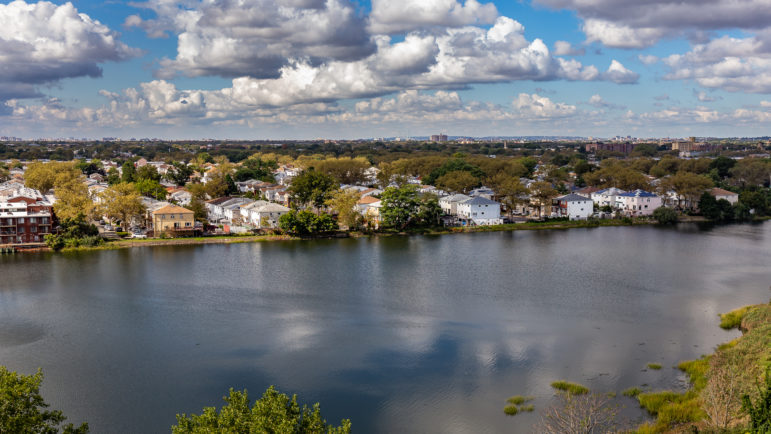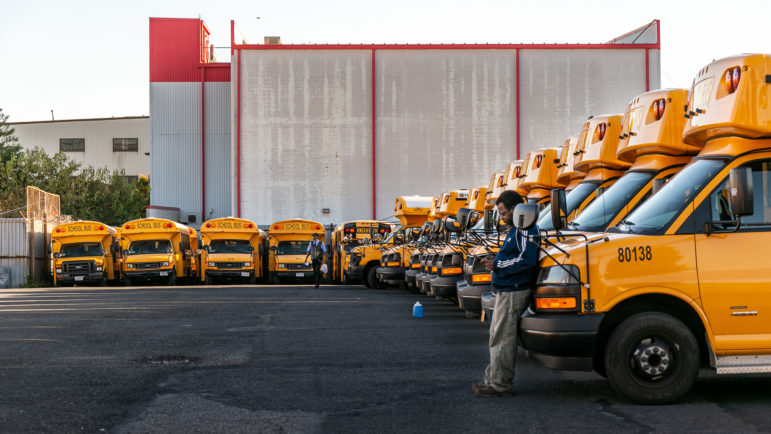“Hurricane Sandy damaged 10 percent of the city’s housing. In a city with a vacancy rate of 4.5 percent, even a temporary loss of the housing supply isn’t just a problem for those directly displaced: it tightens the market for everyone, making it harder and more expensive to find housing.”

Adi Talwar
Waterfront homes in Canarsie, Brooklyn.Ten years ago, Hurricane Sandy brought a surge of flooding that took 43 lives, knocked out power to over 2 million New Yorkers, and damaged the homes of 850,000 people. The storm changed New York in many ways: flood maps were redrawn, building codes revised, and cadres of engineers worked to adapt the city’s shore. The federal government provided over $18 billion for the city to repair damage and mitigate climate risk. Yet, more New Yorkers than ever are vulnerable to displacement from extreme weather.
It is misleading to describe climate disasters as external shocks to the system. These devastating events reveal that the government and housing markets are failing New Yorkers every day. Regardless of the weather, the Sandy recovery experience made clear that the toolkit of disaster recovery programs are not designed for, and in the case of some programs, even permitted, to correct the persistent housing challenges that make people vulnerable to climate catastrophes.
READ MORE: 10 Years After Sandy, New York Considers New Funding for Voluntary Relocation
Sandy changed New York in many ways, including making the city’s chronic housing shortage significantly worse. In 2012, before Sandy, over 45,000 New Yorkers sought emergency shelter every night. Over the last decade, this number has only grown: each night the shelter population is more than 60,000 people.
Hurricane Sandy damaged 10 percent of the city’s housing. In a city with a vacancy rate of 4.5 percent, even a temporary loss of the housing supply isn’t just a problem for those directly displaced: it tightens the market for everyone, making it harder and more expensive to find housing. Decades of failure have created this inequality and insecurity, and federal disaster recovery programs do nothing to remedy this challenge.
New York City is a city of renters: over 60 percent of New Yorkers rent their homes. Yet federal assistance tools for rental tenants are limited, cumbersome to administer, and rarely expand the supply of affordable housing. Without more housing, renters are forced into greater financial and physical precarity. Disaster recovery programs do not recognize the conditions of economic captivity created by the failure of the housing market. Consequently, renters, and low-income residents generally, experience restrictions on their mobility in the housing market and find themselves stuck in the flood zone.
Columbia University’s Frontlines Community Project investigated the relationship between federal post-disaster recovery spending and housing inequality in New York City’s Sandy-affected neighborhoods. Researchers found that rents increased citywide, but rents in neighborhoods that experienced Sandy inundation accelerated at a faster rate, and, in particular, communities that were once comparatively affordable places to live became just as expensive as neighborhoods that did not flood at all.
These market changes were not distributed equally across inundated neighborhoods. While gross rents declined in some majority white neighborhoods, all majority non-white neighborhoods experienced an increase in gross rents. Compared to majority white neighborhoods, median home values accelerated at a faster pace in majority non-white neighborhoods.
New York’s experience is not unique. Over the last 10 years, the United States has experienced at least 10 climate-related disasters that have each caused over a billion dollars in damages. Describing damages in dollars understates the multi-generational impacts of housing loss and insecurity created by climate events. From Hurricane Ian just last month, the 2018 Camp Fire in California, Hurricane Harvey in Texas, and Hurricane Maria in Puerto Rico, affordable housing was permanently lost and not created elsewhere.
Federal disaster recovery tools, by primarily focusing on the restoration of pre-storm housing conditions—in particular, the repair and reconstruction of single-family homes— disproportionately assist middle class white homeowners. Programs that could meaningfully assist renters, like FEMA’s Disaster Housing Assistance Program, are not offered. And new housing construction incentives, like expanded tax-credit programs or even direct grants; are rarely included by each disaster’s specific allocation by Congress.
Most people do not want to live in harm’s way—there are simply not enough climate-safe places to live. Affordable housing construction should be a significant part of disaster recovery, but a focus on remaking places as they were rather than as they should be has created a quagmire of regulations. This makes it extraordinarily difficult for cities to build back better. It is time for FEMA and HUD to view new affordable housing development as climate risk mitigation.
We are now in an age of perpetual housing insecurity. Therefore we need federal climate policies that are responsive to local context, including the housing market. We need aggressive regulatory reform to outlaw the remnants of Jim Crow, and the myriad local, state and federal laws that inhibit equitable disaster recovery. There are no more disasters, we are in one now, until we build our way out and make safe, efficient, affordable housing an inalienable human right.
The authors are staffers at Columbia University Graduate School of Architecture, Planning & Preservation: Deborah Helaine Morris is an assistant adjunct professor and research scholar in urban planning; Thaddeus Pawlowski is managing director, research scholar and adjunct associate professor at the school’s Center for Resilient Cities and Landscapes; Hugo Sarmiento is an assistant professor in urban planning.










One thought on “Opinion: New York’s Climate Crisis is a Housing Crisis”
The article on housing shortage by Columbia students misstates the problem.
The issue is real and the City and State needs to get better control of market rate rent for residential and commercial properties to solve the most pressing problems.
Instead of focusing on solutions, the students warned about shortages, e.g., 60,000 ‘New Yorkers’ in shelters, programs to help single family homes mostly benefit white families, etc.
The shelters are not filled with New Yorkers ever since the city pols decided to make it a sanctuary city. Providing temp shelter for indigenous NYers would have been doable but not for every person or family that comes to town. That program serves mostly non whites. The new hotel room program for illegals(not refugees which is legal sratus granted by US gov’after applying, vetting and connecting to sponsor. Mexican drug and childtrafficking cartels are not sponsors)also serves overwhelmingly non whites but that was ignored by students.
The single family home program uses real estate tax dollars paid by homeowners to restore communities of all skin tone.
Turning this into racial issue is predictable and not helpful.
Is it OK with these students that whites lose their homes which can destroy historic communities?
The housing shortage issue for almost all incomes is important enough without salting the wound with racism.